Infineon公司的MA12070是模拟输入无滤波器高效4V到26V的音频放大器,采用专有的多级开关技术,支持4-26V电源范围,可以用在多个领域.多级开关技术在工作时具有很低的功率损耗.在广泛的音频产品中满额功率时可用在无滤波器的配置.MA12070具有嵌入数字功率管理方案.功率管理算法动态调整开关频率和调制,以优化输出功率范围内的功率损耗和EMI.4阶反馈回路保证了低失真和高的PSRR.器件还提供高度灵活输出级配置,范围从单端输出到单个并行BTL输出.MA12070的保护特性包括DC,短路,超温和欠压状态.MA12070的空闲功耗小于160mW,输出2W时的效率大于80%(1kHz 正弦 8Ω),满功率时的效率大于91%(1kHz 正弦 8Ω).音频性能的DNR大于110dB(A-w, rel. to 1% THD+N powerlevel),输出综合噪音(A律)为45μV,高输电平时的THD+N为0.004%.连续输出功率2x30W,峰值输出功率2x80W.主要用在电池供电扬声器,无线和坞站扬声器,条形音箱,多房间系统和家庭影院.本文介绍了MA12070主要特性,应用框图以及评估板DEMO_BASSAMP_60W_MA12070主要特性和指标,经典美国电子管贝斯放大器和MA12070贝斯放大器拓扑图以及评估板电路图,材料清单和PCB设计图.
The MA12070 is a super-efficient audio power amplifierbased on proprietary multi-level switching technology.It supports a 4-26V supply voltage range, allowing it tobe used in many different applications.
Multi-level switching enables very low power lossduring operation. In addition, it allows the amplifier tobe used in filterless configurations at full rated powerin a wide range of audio products.
The MA12070 features an embedded digital powermanagement scheme. The power managementalgorithm dynamically adjusts switching frequency andmodulation to optimize power loss and EMI across theoutput power range.
A 4th order feedback loop ensures low distortion and ahigh PSRR.
The MA12070 operates from a single power stagesupply voltage (PVDD) and a +5V system supply voltage(DVDD, AVDD).
Highly flexible output stage configurations are offered,ranging from four single-ended outputs to a singleparallel-BTL output.
The MA12070 features protection against DC, shortcircuits,over-temperature and under-voltagesituations.
Flexible “Power Mode Profiles” allow the user to utilizethe multi-level switching technique for very low powerloss or very high audio performance.
Device configuration is controlled through an I2Cinterface as well as dedicated control pins.
MA12070主要特性:
• Proprietary Multi-level Switching Technology
◦ 3-level and 5-level modulation
◦ Low EMI emission
◦ Filterless amplification
◦ Digital Power Management Algorithm
• High Power Efficiency (PMP4)
◦ <160mw Idle power dissipation (26V PVDD,all channels switching)
◦ >80% Efficiency at 2W power (1kHz sine, 8Ω)
◦ >91% Efficiency at Full Power (1kHz sine, 8Ω)
• Audio Performance (PMP2)
◦ >110dB DNR (A-w, rel. to 1% THD+N powerlevel)
◦ 45μV output integrated noise (A-w)
◦ 0.004% THD+N at high output levels
• 4th Order Feedback Error Control
◦ High suppression of supply disturbance
◦ HD audio quality
• Supply Voltages: +4V to +26V (PVDD) and +5V(A/DVDD)
• Selectable Gain (20dB/26dB)
• 2x30W continuous output power (RL = 8Ω at 22V,PMP4, 10% THD+N level, without heatsink)
• 2×80W peak output power (26V PVDD, RL = 4Ω,10% THD+N level)
• 2.0, 2.1, 4.0, 1.0 Output Stage Configurations
• Protection
◦ Under-voltage-lockout
◦ Over-temperature warning/error
◦ Short-circuit/overload protection
◦ Power stage pin-to-pin short-circuit
◦ Error-reporting through serial interface (I2C)
◦ DC protection
• I2C control (four selectable addresses)
• Heatsink free operation with EPAD-down package
MA12070封装:
• 64-pin QFN Package with exposed thermal pad(EPAD) and Lead-free Soldering
MA12070应用:
• Battery Operated Speakers
• Wireless and Docking Speakers
• Soundbars
• Multiroom Systems
• Home Theater Systems
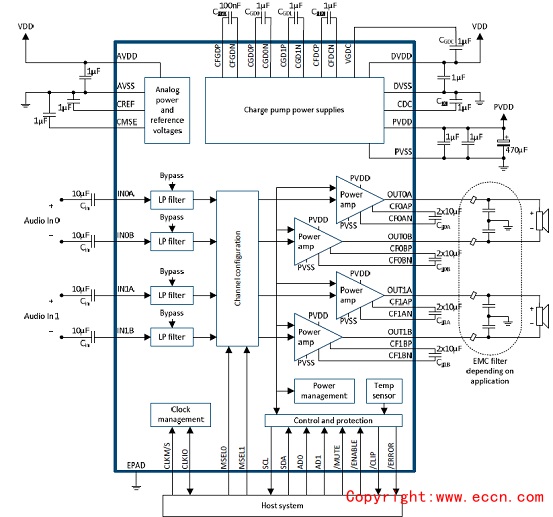
图1.MA12070应用框图
评估板DEMO_BASSAMP_60W_MA12070
Design approach for a MERUS™ MA12070 based musical instrument bass amplifier
DEMO_BASSAMP_60W_MA12070
In the music industry, specifically for amplifying electric guitars and bass guitars, vacuum-tube amplifiers (tube amps) are often regarded as superior in sound to solid-state amplifiers. The practical drawbacks of using vacuum tubes are obvious which are namely, high power consumption, high voltages, questionable reliability, poor mechanical stability, large size, heavy weight and high costs.
Digital emulation (DSP) of tube amplifiers has been designed to overcome many of these drawbacks, but while being very reliable, flexible and comparable in sound, digital emulations seem to miss some characteristics and the feel of a real tube amp.
Hybrid amplifiers combining vacuum-tube and solid-state circuitry have been produced. These amplifiers often cater to the low- to mid-price segment of amplifiers. Use of a tube is often more just for looks and sometimes even not electrically included in the circuit. It is not so much for sound.
Designing an amplifier for musical instruments is quite a different task from designing a hi-fi amplifier. The general consensus on designing a good hi-fi amplifier is that the amplifier should be made so as not to color the sound in any way: having very little total harmonic distortion, very flat frequency response, very wide bandwidth and excellent transient capability. With an electronic magnifying lens.
Not so for the musical instrument amplifier. The musician wants to use the amplifier as a sound-shaping tool, and often to shape the sound in a new and different way. This generally requires the amplifier to exhibit the diametrically opposite qualities to a hi-fi amplifier:
· Instrument amplifiers help shape and create sounds
· Hi-fi amplifiers play back and reproduce sounds
To exemplify this, consider what makes the sound different between a piano and a guitar playing the same note, e.g., A-flat. The A-flat note has a fundamental frequency of 440 Hz. A piano playing an A-flat note sounds very different to a guitar playing the same A-flat note. The harmonic spectrum of a piano is very different to the harmonic spectrum of a guitar as it distorts the fundamental 440 Hz tone in a different way, thus creating the sound of a piano rather than the sound of a guitar.
Musicians often like tube amps for amplifying their instruments. Tube amps sound fuller and more complex with more pleasant overtones, especially when overdriven. This is due to the inherent high distortion characteristics and somewhat slower dynamic behavior of the vacuum tube, especially the triode vacuum tube, where even harmonic distortion components dominate the spectrum. The human ear generally prefers even harmonic distortion components over uneven harmonics in the fundamental tone.
The Infineon MERUSTM MA12070 musical instrument bass amplifier presented here represents a different approach to hybrid amplifier design. It combines the ultrahigh fidelity and musicality of the MA12070 power amplifier with the characteristics of a 12AU7 triode vacuum tube pre-amplifier set up for real-signal class-A amplification. The 12AU7 triode tube is run at low plate-voltage, excluding high-voltage generation circuitry.
Compared to a classic tube amp, the power consumption, cost, size and weight are dramatically reduced. Therefore, reliability and safety are correspondingly dramatically enhanced.
评估板DEMO_BASSAMP_60W_MA12070主要特性:
The key features and performance of the MA12070 musical instrument bass amplifier are as follows:
· One classic tube sound bass instrument channel
· 1 x 60 W at 4 Ω speaker output
· Powered by off-the-shelf regulated wall adapter (+24 V DC/3 A)
· Unparalleled power efficiency – with very low power losses and cool operation
· No external heatsink (full volume, bass instrument playing)
· Dual 12AU7 triode class A pre-amp run directly on adapter voltage for genuine tube sound
· Passive instrument input jack with -12 dB input pad switch for active instruments
· Gain and volume controls for tube overdrive
· Bright switch for slap-bass sound
· Dynamic “breathe and feel” when fully dimmed
· Classic three-band passive Baxandall tone control: treble, middle, bass
· Stereo 3.5 mm AUX input for practicing/street accompaniment
· XLR DI: frequency-compensated, true balanced output for live PA/mixing desk (phantom power safe)
· XLR DI ground switch
· Protection: power supply reverse polarity and hot-plug, thermal, DC and speaker short-circuit
· Speaker jack output with low-cost LC filter
· DC barrel input jack
· Low idle power consumption even with vacuum tube (2.7 W)
· Small dimensions: 185 mm x 60 mm x 30 mm
评估板DEMO_BASSAMP_60W_MA12070主要指标:
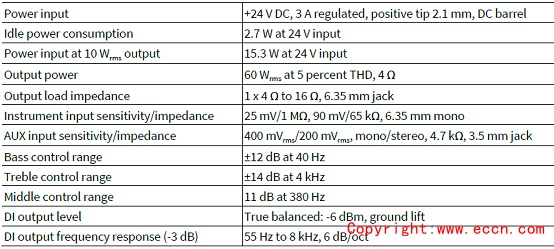
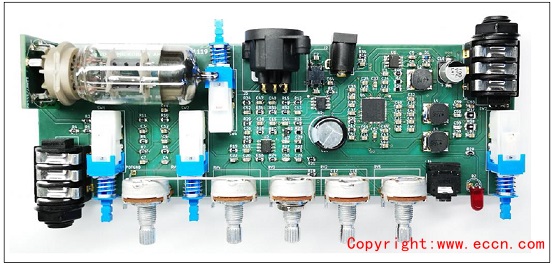
图2.MA12070乐器贝斯放大器板外形图
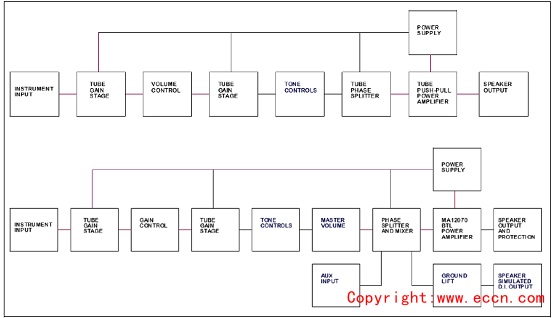
图3.经典美国电子管贝斯放大器(上)和MA12070贝斯放大器(下)拓扑图
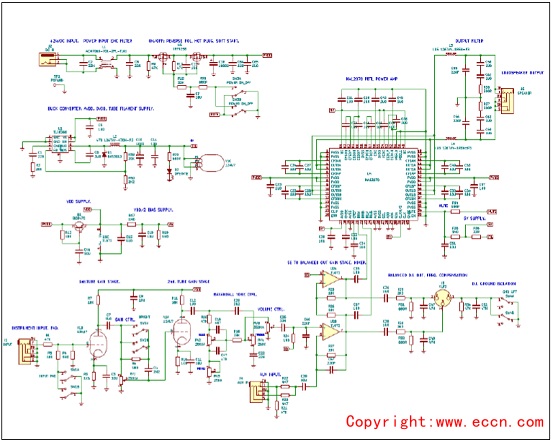
图4.MA12070乐器贝斯放大器电路图

图5.EMC输入滤波器电路
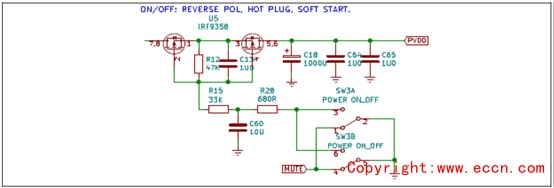
图6.开/关开关,分向极性和热插拔保护电路图
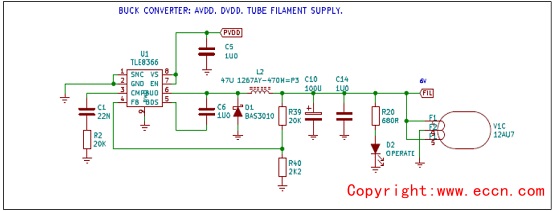
图7.电子管灯丝,模拟和数字降压转换器电源
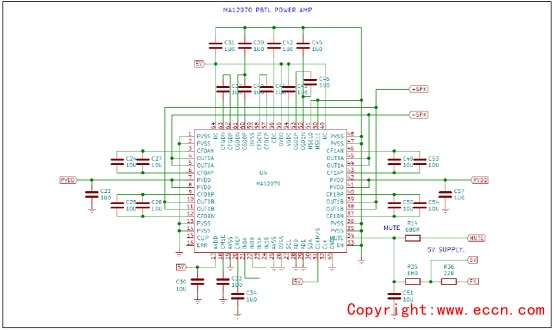
图8.MA12070 PBTL功率放大器
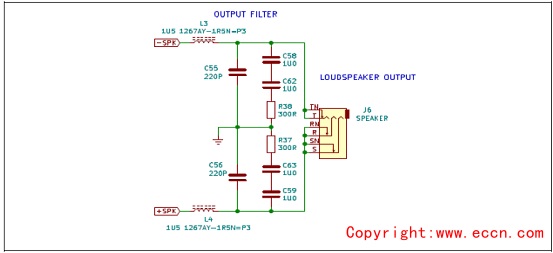
图9.输出缓冲器
MA12070乐器贝斯放大器材料清单:
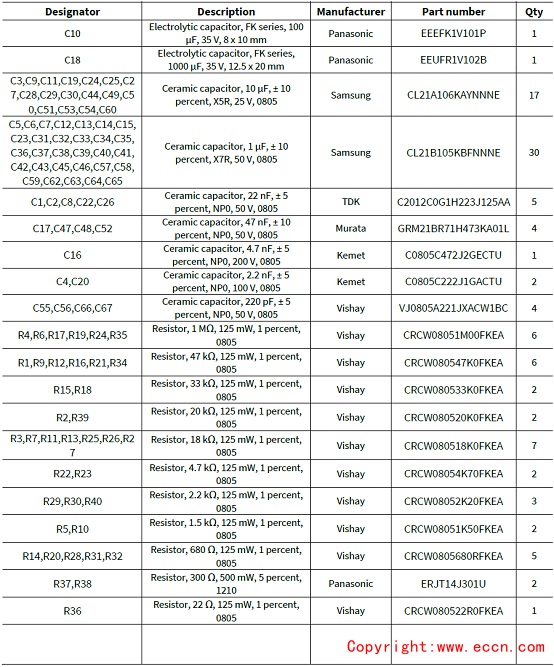
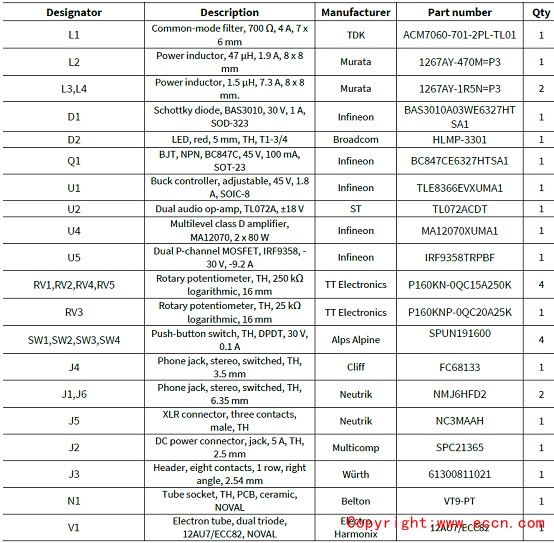
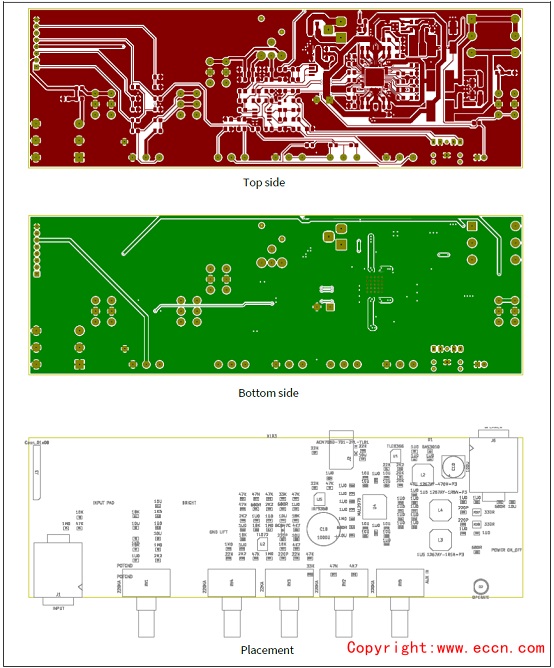
图10.主板PCB布局图

图11.电子管PCB布局图

